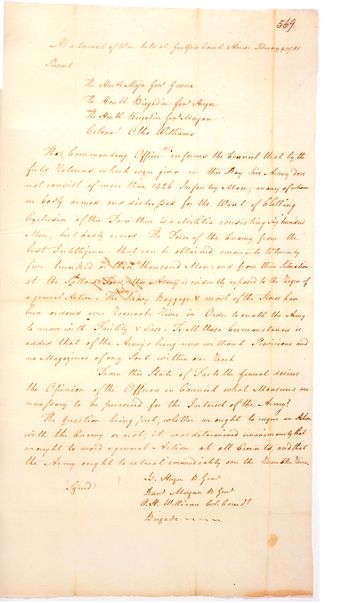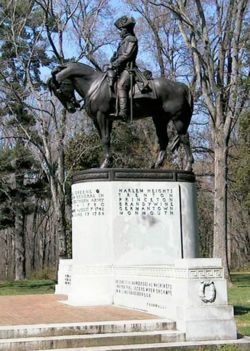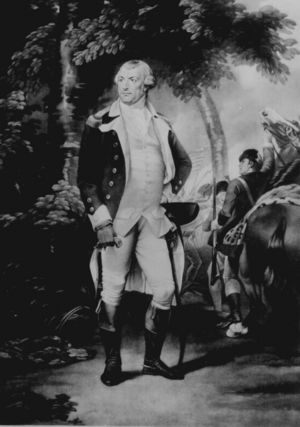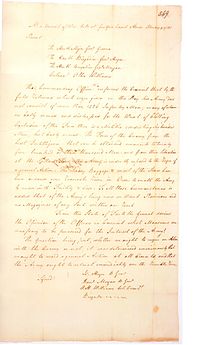Nathanael Greene

Nathanael Greene, Jr. (1742-1786) was a general in the Continental Army during the American Revolution. He became one of George Washington's most trusted aides. He also served as Quartermaster General and played a major role in defeating the British as Commander of the Southern Army in 1780-81.
Greene's performance ranks him second only to Washington during the war. Although having no prior military experience and being largely self-educated, he was a natural leader and an unwavering patriot. He earned the respect of his contemporaries by winning strategic victories in the South, where more experienced generals had failed.
Early Life
Nathanael Greene was born in Rhode Island into a prosperous, Quaker family. His formal education was limited to basic math and reading, as his father believed that secular learning would lead to temptation and sin. His reading material was restricted to the Bible and Quaker texts written by George Fox and Robert Barclay.[1] While these provided for Greene's moral beliefs, he had a thirst for knowledge that could not be satisfied. When he would take business trips to Newport, he would to seek out educated men that he could learn from. One such scholar that he met was Ezra Stiles, the future president of Yale College. Stiles proved to be a powerful influence on Greene's reading habits, exposing him to authors such as John Locke, Sir William Blackstone, and Jonathan Swift.
In November of 1770, Greene's father passed away and the family business was split among his brothers, with Nathanael running the newly built foundry in Coventry. He had cause to spend more time in Newport which allowed him to experience the growing unrest in reaction to British imperial policies toward the colonies. As his self education continued to develop, he became fascinated by military texts such as Instructions to His Generals by Frederick the Great and Mes Reveries by Maurice de Saxe.
The event that pushed Greene toward the revolutionary cause occurred in 1772 when the merchant vessel Fortune, a ship working for the Greenes, was seized by the British. The HMS Gaspee, under the command of William Dudington, boarded the boat while it was anchored in Narragansett Bay. Discovering a large supply of rum and sugar, Dudington declared the ship a smuggling vessel and had it towed to Boston. Greene was outraged and began a fierce writing campaign, including filing a court case against Dudington in Rhode Island. The Gaspee would continue its raids off the coast of Rhode Island until it ran ashore pursuing another merchant vessel. A group of Rhode Islanders arrested Dudington and his crew, and burnt the Gaspee. Greene was not a part of this group, however, he was able to take him to court after his arrest.
In 1774, Greene married Catherine "Caty" Littlefield, niece of Catherine Ray Greene who was married to William Greene and longtime friend of Benjamin Franklin. Soon after the marriage Greene began his military career by joining a local militia. In October, the militia was incorporated into the local "Kentish Guard" and Greene held the rank of private. He aspired to become an officer, but he walked with a limp in his right leg and was told by his fellow militiamen that an officer with a limp would be an embarrassment. Greene, a man always sensitive to criticism, was deeply wounded by these comments. Following the battles at Lexington and Concord in April 1775, the Rhode Island legislature decided to form an army, which they dubbed the "Army of Observation", and on May 8, 1775 they appointed Greene, a man with no military experience, as it's commanding officer.
American Revolution - The early years in the north
Siege of Boston
Greene's army reached Boston on May 23, 1775 to aide in the siege of Boston, which was controlled by British forces under the command of General Thomas Gage. Greene quickly gained the reputation of being a staunch disciplinarian, making his troops focus on training rather than drinking and gambling. Greene recognized early on that an adequate supply system would be necessary to ensure success. Greene returned to Providence in early June to acquire more supplies, and this would cause him to miss the Battle of Bunker Hill. The British won the battle with significantly more casualties than the Americans, a lesson was not lost on Greene, who realized that although the British may take the field at the end of the day, the Americans could win in the long term as long as they could inflict significant losses.
The Second Continental Congress realized the need to formally organize the army and on June 14, 1775 the Continental Army was formed. Command was given by consensus to George Washington of Virginia. Greene was appointed as one of eight brigadier generals. When Washington arrived outside of Boston, he assigned Greene and his troops to defend Prospect Hill, under the command of Major General Charles Lee. In January, following the arrival of Greene's friend Henry Knox with 59 cannons taken from Fort Ticonderoga, a plan was devised to force the hand of British General William Howe. Under the cover of night and artillery shelling, the American troops took and fortified the Dorchester Heights, giving their artillery a commanding view of Boston. Greene was assigned to repel any British attempt to dislodge the Americans, but that would never happen as Howe, fearing a second Bunker Hill, evacuated Boston. On March 18, 1776, as the Americans entered Boston, Washington appointed Greene as the commander of the city.
Defense of New York
Greene’s command of Boston was less than two weeks, as Washington ordered him to take five regiments and march towards New York, the next likely target of the British. Demonstrating his growing confidence in the young general, Washington placed him in charge of Long Island, bolstering the defenses of the strategically important island. On June 29th, the British Navy arrived in the harbor, and shortly after British troops landed on Staten Island to prepare for the invasion. On August 9, Greene was promoted to the rank of Major General. Shortly afterward, as the British were about to proceed, Greene became seriously ill and was bedridden. Command of Long Island was passed on to Major General Israel Putnam, who while being an able commander was not familiar with Greene's strategies and preparation. The Battle of Long Island was disastrous for the Americans, and they were forced to abandon the island. Greene would suggest that the Continental Army should retreat and burn the city. Congress would forbid the burning, but the army did retreat. During this retreat, Greene would experience his first combat at the Battle of Harlem Heights, where he forced a small advancing British unit to retreat.
Fort Washington
The following day, Washington ordered Greene to New Jersey to defend against a probable British advance toward Philadelphia. Green chose to defend Fort Washington and hoped to lure the British into a second Bunker Hill scenario. On November 5, the guns of Fort Washington attacked three British warships attempting to sail up the Hudson River. The ships managed to pass through, leading Washington to question the value of defending the fort and suggested that Greene abandon it. Greene did not heed Washington's advice. On November 16, General Howe ordered ten thousand of his troops to attack Fort Washington. The British took the fort in a matter of hours, although Greene was able to escape to Fort Lee. Greene was openly blamed for this disaster and became the target of widespread criticism from both Congress and his colleagues. Washington, however, chose not to remove Greene from his duties as general. On November 20, British General Richard Cornwallis landed in New Jersey to finish off the Americans. Greene and the Americans would make a disheartening retreat to the Delaware River. It was on this trek that one of Greene's soldiers, Thomas Paine, would write the famous words, "These are the times that try men's souls." in his patriotic pamphlet The Crisis.
Other Battles
On Christmas Eve, with expiring enlistments once again looming, Washington's generals met at Greene's quarters to plan a surprise attack on Trenton, which was controlled by Hessian mercenaries. Greene commanded one of two main invading columns which crossed the Delaware River by cover of night, in a successful attack known as the Battle of Trenton. After winning another battle at Princeton, the Continental Army retired to Morristown, which Greene had the foresight to secure while he was commanding Fort Washington.
Greene's next encounter with the British would be at the Battle of Brandywine in September 1777. General Howe had sent a decoy attack on Chadd's Ford, the most logical place to cross the Brandywine. Greene, in command of the reserve troops, was sent to defend against the surprise main attack on their right flank. Greene arrived in time to prevent retreating General John Sullivan's troops from being routed. While the Americans suffered heavy casualties, Greene's heroics prevented a fatal blow and showed the mettle of his troops. The British would continue on to take Philadelphia on September 26.
General Howe and most of his troops were camped just north of Philadelphia in Germantown. On October 4, the Battle of Germantown began at dawn with another surprise attack. Greene was given command of 5,000 men, over half of the American force, in attacking the right flank. In their nighttime march toward Germantown, Greene's troops got lost, delaying their arrival and costing them the advantage of surprise. In lieu of the botched plan, Greene's troops performed well, however at the end of the day they were forced to retreat. Their recent lack of success had earned Greene numerous detractors, accusing him of manipulating Washington with bad advice.
Quartermaster General
The army would make camp at Valley Forge for the winter, exhausted and under supplied. The army was forced to forage and take what they needed from the local citizens, an operation which Greene was in charge of. His success led Washington and Congress to name him Quartermaster General on March 2, 1778. Washington stressed that his knowledge of soldier's needs in the field, as well as his experience running the family business, made him an ideal choice. He was not excited about the prospect of leaving the field for a less glorious position, but was always eager to impress Washington. He accepted with the caveats that he could remain at Washington's side and appoint two of his friends as his assistants. His service would prove invaluable to the American cause. He established a series of supply depots in strategic locations in order to facilitate quicker movement and would constantly scout ahead to find adequate places for the army to camp.
On top of his new duties, Greene would participate in several more battles. The British, now under the command of General Henry Clinton, had decided to vacate Philadelphia after learning that the French had signed a treaty to aid the Americans. On June 19, Greene joined the troops in leaving Valley Forge in pursuit. In a meeting with his generals, Washington was advised that he should wait for French reinforcements instead of engaging Clinton. Greene was convinced that they should offer a smaller attack at the Battle of Monmouth, and sent a private letter to Washington explaining his reasons. Washington heeded his advice, and although the attack did not go as planned, Greene commanded troops that battled the British to a stalemate. In August, Washington granted him a brief respite from his quartermaster duties so he could participate in what was to be the first Franco-American joint attack of the war, which was an unsuccessful attempt to recapture Newport, Rhode Island. The relationship between France and America had come into jeopardy when French Admiral d'Estaing called off the attack because his ships needed to be repaired. This had caused ill-advised heated words from the American commander, John Sullivan. Greene, with the aide of the Marquis de Lafayette, acted as a diplomat and was able to calm the French reaction and preserve the alliance.
Towards the end of 1779, Greene began to grow frustrated with the lack of support for the Quartermaster's office. Congress had decided to remove itself from the supply business and placed the responsibility on the individual states to provide supplies within their boundaries. Supplies were running low and Greene blamed Congress for its multiple commissions and reorganizations of his office. He wrote a highly critical letter to Congress on July 26 demanding his resignation and condemning their behavior. There was even talk of removing him from the army altogether, to which Washington objected. He was officially replaced on August 5, 1780.
The Trial of Major John Andre
In late September of 1780, following the treason of Benedict Arnold, Greene replaced the traitor as commander of West Point. Washington appointed him to head the committee of 14 generals that would oversee the the trial of British Major John Andre, Arnold's accomplice who had been captured attempting to cross back into friendly territory. The trial took place on September 29, 1780 and the generals unanimously found Andre guilty and sentenced him to death. Greene, on Washington's behalf, met with the British who claimed Andre was working under a flag of truce, although this contradicted his own testimony. Many American officers requested that Andre, who had become somewhat of a sympathetic figure, be executed by firing squad which would be more befitting his station. Greene argued against this, believing Andre deserved no better than any other traitor. Andre died by hanging on October 2, 1780.
Commander of the Southern Campaign
Events in the South had been going poorly for the Americans in 1780. In May, General Benjamin Lincoln was forced to surrender at Charleston and in August the army of General Horatio Gates was destroyed. Congress gave authority to Washington to appoint a replacement for Gates and he selected Greene. Greene was thrilled by the chance to return to a field commander position, even though the scenario set before him was daunting. The main concern was rebuilding the army and being able to supply it. Greene proceeded from state to state in search of support en route to Charlotte, North Carolina, where he officially took command of the remaining army on December 2, 1780.
Success at Cowpens
The army was weak and badly equipped and was opposed by a superior force under Cornwallis. On December 16, 1780, Greene made a decision that went against all military conventions - he divided his army into two parts even though he was facing a much larger army. Greene, with the majority of the army, would march into northeastern South Carolina, while a group of 600 under the command of Brigadier General Daniel Morgan would move into the western part of the state. Greene reasoned that the split would ease logistical problems, as well as put Cornwallis in a bind as to where to concentrate his troops. By dividing his own troops, he forced the division of the British as well, and created the possibility of a strategic interplay of forces. Morgan's orders were to aggravate Cornwallis' left flank and to bolster patriot morale in the backcountry. This strategy led to General Daniel Morgan's victory of Cowpens on January 17, 1781, where nearly nine-tenths of the entire British force were killed or captured.
The Strategic Retreat
With over 800 prisoners Morgan began a retreat, moving north towards Salisbury where he was joined by Greene at Cowan's Ford on the Catawba River. To draw the British further away from their supply base and to wear them down Greene then wrote to Huger to direct his troop movement to Guilford Courthouse.
Arriving on February 9 at Guilford, Greene summoned his field officers to a council of war of his chief officers and put forward the question of whether the army should give battle. It was voted that for the time being, the army should continue retreating to gather more forces, and defer engagement with Cornwallis. On the tenth he writes to Patrick Henry requesting troops, "If it is possible for you to call forth fifteen hundred Volunteers & march them immediately to my assistance, the British Army will be exposed to a very critical & dangerous situation."
"In all probability you will find me on the North side of Dan River. I must repeat it, the present moment is big with the most important consequences, & requires the greatest & most spirited exertions."
Cornwallis, angered by the defeat at Cowpens, sent the bulk of his army after Morgan, burning their excess supplies so they could move faster. Greene reunited with Morgan's troops on January 30, 1781, and they began a planned retreat to the town of Guilford Court House in North Carolina.
Race to the Dan River

The Council of War letter (this copy made contemporaneously with original) that Greene sent of the proceedings to Samuel Huntington, the president of Congress. Written at Guilford Court House on February 9. 1781. This is a scan of the photograph from the National Archives.
Greene at this same time formed a special light corps to be commanded by Col. Otho Williams to cover the main army’s retreat. In a letter to George Washington on February 9, he described the "light army" he had formed under Williams as composed of: "cavalry of the 1st and 3rd Regiments and the Legion amounting to 240, a detachment of 280 Infantry under Lieut. Col. Howard, the Infantry of Lieut. Col. Lee's Legion and 60 Virginia Riflemen making in their whole 700 men which will be ordered with the Militia to harass the enemy in their advance, check their progress and if possible give us opportunity to retire without general action." Also saying "I called a Council, who unanimously advised to avoid an action, and to retire beyond the Roanoke immediately. A copy of the proceedings I have the honor to inclose." The re-united army only numbered two thousand and thirty-six men, including fourteen hundred and twenty-six regulars. Col. Edward Carrington joined the command, with the report that boats had been secured, and secreted along the Dan River in Virginia, so as to be collected on a few hours' warning. The British army was at Salem, only twenty-five miles from Guilford. This was on the tenth of February.
By the fourteenth, Greene's army had outrun the British and crossed the Dan River at Irvine's and Boyd's ferries in Halifax County, Virginia. Cornwallis got the news in the course of the evening. The river was too high to cross without boats, and every boat was on the farther shore. Greene had won the race.
"This American retreat, which extended across the breadth of North Carolina, is considered one of the masterful military achievements of all time." Dennis M. Conrad, Project Director and Editor, The Papers of General Nathanael Greene
In a letter to General John Butler, Greene writes "I have some expectation of collecting a force sufficient in this County to enable me to act offensively and in turn race Lord Cornwallis as he has done me."
Battle of Guilford Court House

By crossing the Dan, Greene was reunited with his supply chain, whereas Cornwallis was now far from his. On February 22, Greene's army crossed back into North Carolina. Greene, staying near to Cornwallis, kept his army moving constantly, frequently using Lighthorse Harry Lee's cavalry to engage in skirmishes. On March 14, he chose his battlefield - the town of Guilford Court House. Greene enacted the same strategy that Daniel Morgan had used at Cowpens. At the end of the day, Greene's army would retreat from the field, but not without inflicting once again heavy casualties among Cornwallis' troops. The Americans had managed to kill or wound over 500 British, which was more than 25 percent of Cornwallis' army, while suffering minor casualties in comparison. Greene's success at Guilford Court House, as well as Cowpens, were decisive turning points in the South.
Recapturing the South
Cornwallis would soon retreat to Wilmington to resupply and rest his army. Greene decided to move his army back into South Carolina. He believed Cornwallis would soon pursue him, but instead the British army would turn its focus on Virginia. Greene engaged Lord Francis Rawdon's troops at the Battle of Hobkirk's Hill, just outside of Camden, on April 24. The Americans were forced to retreat, with even casualties on both sides. Rawdon, however, would remove his damaged army from Camden to Charleston, conceding most of South Carolina. Greene pressed forward and won victories at several British forts, forcing their enemy to the coast. Greene encamped his men for six weeks before marching them to Eutaw Springs on September 9 to engage the British, now under the command of Alexander Stewart. Greene again was forced to retreat, but the battle had been extremely bloody and the losses he inflicted on the British great. This would be Greene's last battle of the war, as Cornwallis would surrender after the Siege of Yorktown a month later.
Post-war life
Greene retired from the army after the war was over. He was given land in South Carolina and Georgia as rewards for his service. He chose the plantation of Mulberry Grove to retire to. His time was spent dealing with false charges of profiteering during the war, as well as dealing with a significant debt. He died from sunstroke on June 19, 1783 and was buried in Savannah. Congress paid off his debt 10 years later.
Notes
- ↑ He was expelled from the Quakers in 1773 because of his military activities.

